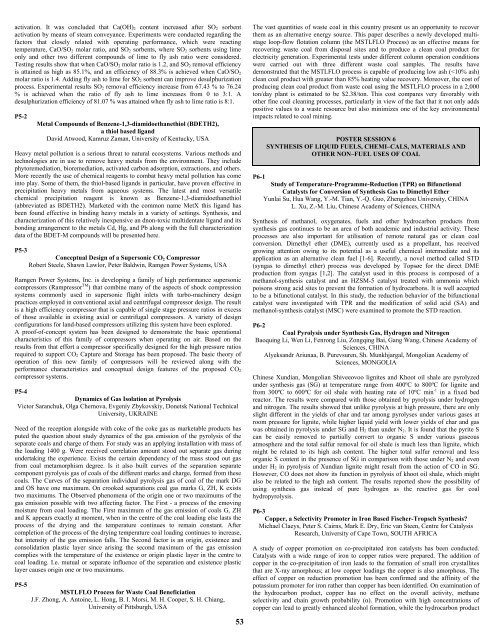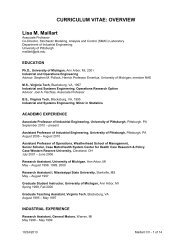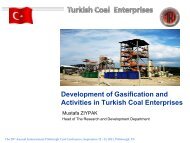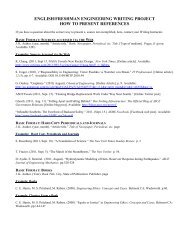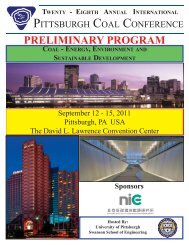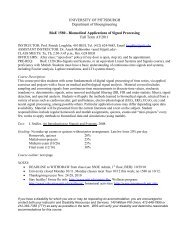Abstract Booklet 2006 - Swanson School of Engineering - University ...
Abstract Booklet 2006 - Swanson School of Engineering - University ...
Abstract Booklet 2006 - Swanson School of Engineering - University ...
You also want an ePaper? Increase the reach of your titles
YUMPU automatically turns print PDFs into web optimized ePapers that Google loves.
activation. It was concluded that Ca(OH) 2 content increased after SO 2 sorbent<br />
activation by means <strong>of</strong> steam conveyance. Experiments were conducted regarding the<br />
factors that closely related with operating performance, which were reacting<br />
temperature, CaO/SO 2 molar ratio, and SO 2 sorbents, where SO 2 sorbents using lime<br />
only and other two different compounds <strong>of</strong> lime to fly ash ratio were considered.<br />
Testing results show that when CaO/SO 2 molar ratio is 1.2, and SO 2 removal efficiency<br />
is attained as high as 85.1%, and an efficiency <strong>of</strong> 88.3% is achieved when CaO/SO 2<br />
molar ratio is 1.4. Adding fly ash to lime for SO 2 sorbent can improve desulphurization<br />
process. Experimental results SO 2 removal efficiency increase from 67.43 % to 76.24<br />
% is achieved when the ratio <strong>of</strong> fly ash to lime increases from 0 to 3:1. A<br />
desulphurization efficiency <strong>of</strong> 81.07 % was attained when fly ash to lime ratio is 8:1.<br />
P5-2<br />
Metal Compounds <strong>of</strong> Benzene-1,3-diamidoethanethiol (BDETH2),<br />
a thiol based ligand<br />
David Atwood, Kamruz Zaman, <strong>University</strong> <strong>of</strong> Kentucky, USA<br />
Heavy metal pollution is a serious threat to natural ecosystems. Various methods and<br />
technologies are in use to remove heavy metals from the environment. They include<br />
phytoremediation, bioremediation, activated carbon adsorption, extractions, and others.<br />
More recently the use <strong>of</strong> chemical reagents to combat heavy metal pollution has come<br />
into play. Some <strong>of</strong> them, the thiol-based ligands in particular, have proven effective in<br />
precipitation heavy metals from aqueous systems. The latest and most versatile<br />
chemical precipitation reagent is known as Benzene-1,3-diamidoethanethiol<br />
(abbreviated as BDETH2). Marketed with the common name MetX this ligand has<br />
been found effective in binding heavy metals in a variety <strong>of</strong> settings. Synthesis, and<br />
characterization <strong>of</strong> this relatively inexpensive an dnon-toxic multidentate ligand and its<br />
bonding arrangement to the metals Cd, Hg, and Pb along with the full characterization<br />
data <strong>of</strong> the BDET-M compounds will be presented here.<br />
P5-3<br />
Conceptual Design <strong>of</strong> a Supersonic CO 2 Compressor<br />
Robert Steele, Shawn Lawlor, Peter Baldwin, Ramgen Power Systems, USA<br />
Ramgen Power Systems, Inc. is developing a family <strong>of</strong> high performance supersonic<br />
compressors (Rampressor TM ) that combine many <strong>of</strong> the aspects <strong>of</strong> shock compression<br />
systems commonly used in supersonic flight inlets with turbo-machinery design<br />
practices employed in conventional axial and centrifugal compressor design. The result<br />
is a high efficiency compressor that is capable <strong>of</strong> single stage pressure ratios in excess<br />
<strong>of</strong> those available in existing axial or centrifugal compressors. A variety <strong>of</strong> design<br />
configurations for land-based compressors utilizing this system have been explored.<br />
A pro<strong>of</strong>-<strong>of</strong>-concept system has been designed to demonstrate the basic operational<br />
characteristics <strong>of</strong> this family <strong>of</strong> compressors when operating on air. Based on the<br />
results from that effort a compressor specifically designed for the high pressure ratios<br />
required to support CO 2 Capture and Storage has been proposed. The basic theory <strong>of</strong><br />
operation <strong>of</strong> this new family <strong>of</strong> compressors will be reviewed along with the<br />
performance characteristics and conceptual design features <strong>of</strong> the proposed CO 2<br />
compressor systems.<br />
P5-4<br />
Dynamics <strong>of</strong> Gas Isolation at Pyrolysis<br />
Victor Saranchuk, Olga Chernova, Evgeniy Zbykovskiy, Donetsk National Technical<br />
<strong>University</strong>, UKRAINE<br />
Need <strong>of</strong> the reception alongside with coke <strong>of</strong> the coke gas as marketable products has<br />
puted the question about study dynamics <strong>of</strong> the gas emission <strong>of</strong> the pyrolysis <strong>of</strong> the<br />
separate coals and charge <strong>of</strong> them. For study was an applying installation with mass <strong>of</strong><br />
the loading 1400 g. Were received correlation amount stood out separate gas during<br />
undertaking the experience. Exists the certain dependency <strong>of</strong> the mass stood out gas<br />
from coal metamorphism degree. Is it also built curves <strong>of</strong> the separation separate<br />
component pyrolysis gas <strong>of</strong> coals <strong>of</strong> the different marks and charge, formed from these<br />
coals. The Curves <strong>of</strong> the separation individual pyrolysis gas <strong>of</strong> coal <strong>of</strong> the mark DG<br />
and OS have one maximum. On crooked separations coal gas marks G, ZH, K exists<br />
two maximums. The Observed phenomena <strong>of</strong> the origin one or two maximums <strong>of</strong> the<br />
gas emission possible with two affecting factor. The First - a process <strong>of</strong> the emoving<br />
moisture from coal loading. The First maximum <strong>of</strong> the gas emission <strong>of</strong> coals G, ZH<br />
and K appears exactly at moment, when in the centre <strong>of</strong> the coal loading else lasts the<br />
process <strong>of</strong> the drying and the temperature continues to remain constant. After<br />
completion <strong>of</strong> the process <strong>of</strong> the drying temperature coal loading continues to increase,<br />
but intensity <strong>of</strong> the gas emission falls. The Second factor is an origin, existence and<br />
consolidation plastic layer since arising the second maximum <strong>of</strong> the gas emission<br />
complies with the temperature <strong>of</strong> the existence or origin plastic layer in the centre to<br />
coal loading. I.e. mutual or separate influence <strong>of</strong> the separation and existence plastic<br />
layer causes origin one or two maximums.<br />
P5-5<br />
MSTLFLO Process for Waste Coal Beneficiation<br />
J.F. Zhong, A. Antoine, L. Hong, B. I. Morsi, M. H. Cooper, S. H. Chiang,<br />
<strong>University</strong> <strong>of</strong> Pittsburgh, USA<br />
53<br />
The vast quantities <strong>of</strong> waste coal in this country present us an opportunity to recover<br />
them as an alternative energy source. This paper describes a newly developed multistage<br />
loop-flow flotation column (the MSTLFLO Process) as an effective means for<br />
recovering waste coal from disposal sites and to produce a clean coal product for<br />
electricity generation. Experimental tests under different column operation conditions<br />
were carried out with three different waste coal samples. The results have<br />
demonstrated that the MSTLFLO process is capable <strong>of</strong> producing low ash (


